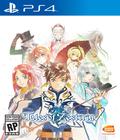Tales of Zestiria follows the adventures of a knight named Sorey, who is aided by unseen partners known as Seraphim. Sorey and his Seraph pals don't have an easy mission. Based on the E3 2015 demo, Sorey is on a quest to rid the world of Malevolence, a sickness that has infected a nearby dragon and made it wild and powerful. The demo began with Sorey trying to clear Malevolence from the environment by slaying infected monsters. It's the only way to weaken it enough so he can attack the dragon and expect to win.
Tales of Zestiria is a first for the franchise in that battles occur on the world map. Rather than teleporting to a new area to fight, the camera pans out, and you can fight where you are. This means you'll have to take environmental objects, like trees and rocks, into account when getting into a fight because they could make it more difficult to hit enemies. The combat camera is also a little different, giving the game a behind-the-back feel at times. In our demo, the camera sometimes got caught on the environment, but it's difficult to say how significant that will be in the final game.
Otherwise, a lot of the Tales combat will feel very familiar. Characters have regular attacks, special moves called Artes, and magical spells. Regular attacks and Artes can be chained together while magical spells require charge time, so the caster must be protected from enemies who want to interrupt their spells. The CC system appears to have been replaced by something called the Spirit Chain system, which looks like a mix of TP and CC. You spend SC to use Artes, and they replenish as you attack. As with CC, precisely timed side-steps, blocks or dodges can fill the SC gauge.
One of the more interesting elements of the game is Armatization, a super-powered combat mode that is similar to the Chromatus in Tales of Xillia 2. Armatization requires Sorey and one of the Seraphim. Each of Sorey's Seraphim pals is tied to a specific element, and when Sorey uses Armatization, he fuses with them to gain access to new moves and weapons based on their element. For example, Mikelo provides a bow and magic-based arts while Edna gives giant stone fists and earth-based arts. It seems that instead of the traditional Tales character swapping, there is a focus on different fusions to change Sorey's play style.
It appears that Tales of Zestiria emphasizes enemy elemental weaknesses. We only got a few glimpses of high-level combat, but it was unmistakably front and center. It makes sense, since the Seraphim are such a central part of the game. When you hit an enemy's elemental weakness or elemental resistance, the game displays a big glowing icon to notify you. This also makes me suspect that enemies can swap resistances on the fly, requiring Sorey to do the same. It seems like you won't be able to depend on a single Armatization, much like Ludger needing to swap between a gun, hammer and swords.
The dungeon exploration in Zestiria felt very familiar. There were more wide-opera spaces in the demo than in Xillia, but by and large, you'll probably have a good idea of what to expect if you've played recent games in the franchise. It looks like there are more hidden things to find. Each Seraphim has a special field action that triggers, such as telling you about hidden treasures in the environment. The fact that you need a character to do this implies there will be things you can easily overlook.
Visually, there hasn't been too big of a change to Zestiria. We saw the PS3 version of the game, but we know there will also be a PS4 version with some upgrades. Additionally, this is the first time a Tales game is coming to the PC, which may have a significant impact on how the game looks and plays. At least for the PS3 iteration, it's very reminiscent of the previous titles in the franchise in terms of character and environmental animations. Longtime fans may even notice a few reoccurring monsters, although I saw a fair share of new ones, too.
Tales of Zestiria doesn't look to reinvent the wheel. The core Tales combat system that people know and love is intact, and while there have been some changes to the basic design, longtime fans will still enjoy the game. There are some new features, such as the Armatization fusion mechanic and the new on-field battle camera, to keep the game feeling fresh, and the story seems like it could be intriguing. It's difficult to get a true feel for an RPG from a short demo, but it looked like classic Tales goodness. Tales of Zestiria will release on Oct. 20 for the PS4, PS3 and PC.
More articles about Tales of Zestiria











 Players delve into a grand storyline and discover the zest of adventure with new characters, magical lands and action-packed gameplay that the "Tales of" franchise is known for.
Players delve into a grand storyline and discover the zest of adventure with new characters, magical lands and action-packed gameplay that the "Tales of" franchise is known for.



















